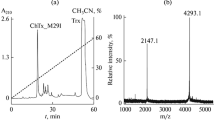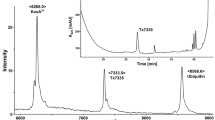Summary
Two charybdotoxin peptides were purified from venom of the Israeli scorpion,Leiurus quinquestriatus hebraeus. Microsequencing of the most abundant toxin, ChTX-Lq1, revealed identity with the 37-residue peptide previously sequenced by Gimenez-Gallego et al. [Gimenez-Gallego, G., et al.,Proc. Natl. Acad. Sci. USA 85:3329–3333 (1988)]. Sequence data on the minor peptide, ChTX-Lq2, showed substantial homology to ChTX-Lq1 with differences observed at eight positions. These two charybdotoxin sequences, along with that of noxiustoxin, define a distinct family of scorpion peptide toxins with activity against K+ channels. Both charybdotoxin homologs inhibited Ca2+-dependent K+ efflux from human erythrocytes with similar potency,K 0.5∼-40nm. In planar bilayer assays of single K(Ca) channels from rat muscle, ChTX-Lq1 and ChTX-Lq2 blocked with intrinsicK d's of 1.3 and 43nm, respectively, in the presence of 50mm external KCl. A new application of dwell-time histogram analysis of single-channel blocking events was used to characterize the kinetic homogeneity of toxin samples and the blocking kinetics of ChTX derivatives. The lower blocking affinity of ChTX-Lq2 was the combined result of a faster dissociation rate and a slower association rate as compared to ChTX-Lq1. The blocking activity of two mono-iodinated derivatives of ChTX-Lq1 was also analyzed. Blocked dwell-time histograms of the iodinated peptides were characterized by predominately brief (0.2–2 sec) blocking events in comparison to the native toxin (20 sec). Histogram analysis revealed that mono-iodination of ChTX-Lq1 impairs blocking activity by adverse effects on both dissociation and association rate constants. Frequency density histograms of single channel blocking events provide a sensitive assay of toxin purity suitable for quantitating structure-activity relationships of charybdotoxin derivatives.
Similar content being viewed by others
References
Abia, A., Lobaton, C.D., Moreno, A., Garcia-Sancho, J. 1986.Leiurus quinquestriatus venom inhibits different kinds of Ca2+-dependent K+ channels.Biochim. Biophys. Acta 856:403–407
Allen, G. 1981. Sequencing of Proteins and Peptides. Elsevier, New York
Anderson, C.S. 1987. The Interaction of Charybdotoxin with the Calcium-Activated Potassium Channel from Mammalian Skeletal Muscle. Ph.D. thesis. Graduate Department of Biochemistry, Brandeis University, Waltham
Anderson, C.S., MacKinnon, R., Smith, C., Miller, C. 1988. Charybdotoxin block of single Ca2+-activated K+ channels: Effects of channel gating, voltage and ionic strength.J. Gen. Physiol. 91:335–349
Burgess, G.M., Claret, M., Jenkinson, D.H. 1981. Effects of quinine and apamin on the calcium-dependent potassium permeability of mammalian hepatocytes and red cells.J. Physiol. (London) 317:67–90
Cahalan, M.D., Lewis, R.S. 1988. Role of potassium and chloride channels in volume regulation by T lymphocytes.In: Cell Physiology of Blood. R.B. Gunn and J.C. Parker, editors. pp. 281–301. Rockefeller University Press, New York
Carbone, E., Wanke, E., Prestipino, G., Possani, L.D., Maelicke, A. 1982. Selective blockage of voltage-dependent K+ channels by a novel scorpion toxin.Nature (London) 296:90–91
Castle, N.A., Strong, P.N. 1986. Identification of two toxins from scorpion (Leiurus quinquestriatus) venom which block distinct classes of calcium-activated potassium channel.FEBS Lett. 209:117–121
Catterall, W.A. 1977. Membrane potential-dependent binding of scorpion toxin to the action potential Na+ ionophore: Studies with a toxin derivative prepared by lactoperoxidasecatalyzed iodination.J. Biol. Chem. 252:8660–8668
Catterall, W.A., Morrow, C.S., Daly, J.W., Brown, G.B. 1981. Binding of batrachotoxinin A 20-α-benzoate to a receptor site associated with sodium channels in synaptic nerve ending particles.J. Biol. Chem. 256:8922–8927
Cook, N.S. 1988. The pharmacology of potassium channels and their therapeutic potential.Trends Pharmacol. Sci. 9:21–28
Gimenez-Gallego, G., Navia, M.A., Reuben, J.P., Katz, G.M., Kaczorowski, G.J., Garcia, M.L. 1988. Purification, sequence and model structure of charybdotoxin, a potent selective inhibitor of calcium-activated potassium channels.Proc. Natl. Acad. Sci. USA 85:3329–3333
Harvey, A.L., Anderson, A.J. 1985. Dendrotoxins: Snake toxins that block potassium channels and facilitate neurotransmitter release.Pharmac. Ther. 31:33–55
Lewis, R.S., Cahalan, M.D. 1988. Subset-specific expression of potassium channels in developing murine T-lymphocytes.Science 239:771–775
Lucchesi, K.J., Moczydlowski, E. 1989. Block of K(Ca) channels by mono-iodinated charybdotoxin derivatives and a newly identified homolog.Biophys. J. 55:547a
MacKinnon, R., Miller, C. 1988. Mechanism of charybdotoxin block of the high-conductance Ca2+-activated K+ channel.J. Gen. Physiol. 91:335–349
MacKinnon, R., Reinhart, P.H., White, M.M. 1988. Charybdotoxin block ofshaker K+ channels suggests that different types of K+ channels share common structural features.Neuron 1:997–1001
Miller, C., Moczydlowski, E., Latorre, R., Phillips, M. 1985. Charybdotoxin, a protein inhibitor of single Ca2+-activated K+ channels from mammalian skeletal muscle.Nature (London) 313:316–318
Moczydlowski, E., Hall, S., Garber, S.S., Strichartz, G.R., Miller, C. 1984. Voltage-dependent blockade of muscle Na+ channels by guanidinium toxins: Effect of toxin charge.J. Gen. Physiol. 84:687–704
Moczydlowski, E., Latorre, R. 1983. Gating kinetics of Ca2+-activated K+ channels from rat muscle incorporated into planar lipid bilayers: Evidence for two voltage-dependent Ca2+ binding reactions.J. Gen. Physiol. 82:511–542
Moczydlowski, E., Lucchesi, K., Ravindran, A. 1989. An emerging pharmacology of peptide toxins targeted against potassium channels.J. Membrane Biol. 105:95–111
Olivera, B.M., Gray, W.R., Zeikus, R., McIntosh, J.M., Varga, J., Rivier, J., deSantos, V., Cruz, L.J. 1985. Peptide neurotoxins from fish-hunting cone snails.Science 230:1338–1343
Podell, D.N., Abraham, G.N. 1978. A technique for the removal of pyroglutamic acid from the amino terminus of proteins using calf liver pyroglutamate amino peptidase.Biochem. Biophys. Res. Commun. 81:176–185
Possani, L.D., Martin, B.M., Svendsen, I. 1982. The primary structure of noxiustoxin: a K+ channel blocking peptide, purified from the venom of the scorpionCentruroides noxius Hoffmann.Carlsberg Res. Commun. 47:285–289
Ravindran, A., Moczydlowski, E. 1989. Influence of negative surface charge on toxin binding to canine heart Na channels in planar bilayer.Biophys. J. 55:359–365
Regoeczi, E. 1984. Iodine-Labeled Plasma Proteins. CRC, Boca Raton, FL
Sigworth, F.J., Sine, S.M. 1987. Data transformation for improved display and fitting of single-channel dwell time histograms.Biophys. J. 52:1047–1054
Smith, C., Phillips, M., Miller, C. 1986. Purification of charybdotoxin, a specific inhibitor of the high-conductance Ca2+-activated K+ channel.J. Biol. Chem. 261:14607–14613
Valdivia, H.H., Smith, J.S., Martin, B.M., Coronado, R., Possani, L.D. 1988. Charybdotoxin and noxiustoxin, two homologous peptide inhibitors of the K+(Ca2+) channel.FEBS Lett. 226:280–284
Watt, D.D., Simard, J.M. 1984. Neurotoxic proteins in scorpion venom.J. Toxicol-Toxin Rev. 3:181–221
Wolff, D., Cecchi, X., Spalvins, A., Canessa, M. 1988. Charybdotoxin blocks with high affinity the Ca-activated K+ channel of Hb A and Hb S red cells: Individual differences in the number of channels.J. Membrane Biol. 106:243–252
Author information
Authors and Affiliations
Rights and permissions
About this article
Cite this article
Lucchesi, K., Ravindran, A., Young, H. et al. Analysis of the blocking activity of charybdotoxin homologs and iodinated derivatives against Ca2+-Activated K+ channels. J. Membrain Biol. 109, 269–281 (1989). https://doi.org/10.1007/BF01870284
Received:
Issue Date:
DOI: https://doi.org/10.1007/BF01870284




